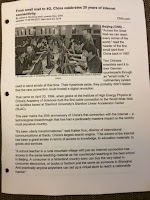The idea of Digital Natives and Digital Immigrants, presented by Prensky, is a hefty one. Do these two groups really exist, and if so, should instruction be modified to adjust to the new normal facing Digital Natives in the classroom? After reading the three articles assigned, I am uncertain how I really feel about the topic, though will do my best to explain my thinking.
I found myself agreeing with many of Prensky's statements, even though they were harsh. Supported by my own anecdotal evidence from experiences I have had with veteran educators and my experience in the classroom, although broad, I found some truth the claims. I have worked with educators that fit Prensky's Digital Immigrant characteristics remarkably well (printing out emails, turning to the internet for information second, and lack of appreciation for the new skills Digital Natives bring to their classroom, just to name a few). Students in my classroom are used to accessing and getting information fast, they like to and they can multitask, and graphics are one of the best ways to relay information, much like the Digital Natives described by Prensky.
Although I recognized these generalized characteristics of Prensky's argument, I found myself attributing those differences to a greater scope of influences than just technology. The people I know that fit the Digital Immigrant camp, are few. Not everyone in the pre-new technology falls into the descriptors Prensky uses. There are many that have mastered and become more technology-literate than I am, even though I would technically be a Digital Native according to Prensky.
I do agree with Prensky that "our students have changed radically" and "are no longer the people our educational system was designed to teach," I just think there are deeper, more complex reasons than just the new technology these students encounter on a daily basis. I believe family structures, life style options and choices, and parenting styles contribute just as much, if not more to the characteristics of the crop of students in our education system than just the new technologies. I have not done research on this, I cannot claim this is researched fact, simply my own observations and experiences reacting to the readings. (So McKenzie could pick my meager thoughts apart just as much as she did Prensky.)
Our educational system can appear antiquated as a whole. The 9-5, Monday-Friday jobs are getting fewer, yet we still run our schools in a similar fashion. New technologies are slowly being integrated. Where individual cell phone use is commonplace in our daily lives and workplaces, it struggles to find its place in the classroom. It is important to recognize that there are incredible teachers and entire schools that fight this notion and have found a way to bring meaningful content in relative ways to these new students.
So, although I agree with parts of Prensky's ideas, there are so many more topics to include in our discussion with colleagues that impact our teaching.
Assigned Articles:




